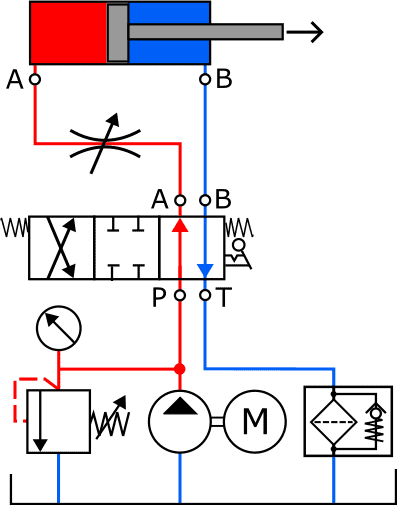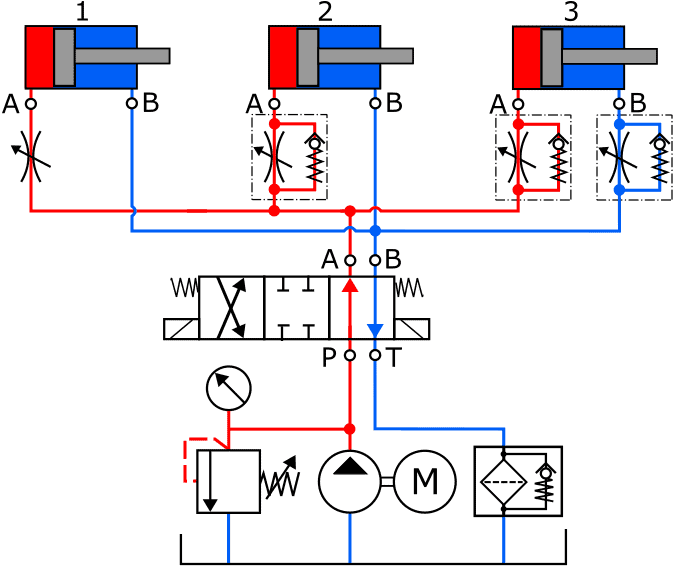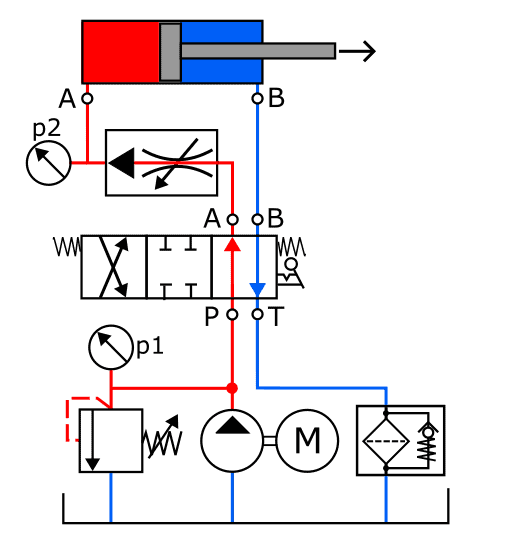Subjects:
- Preface
- throttling
- Flow Control Valve
Preface:
In hydraulic installations it can be important to be able to control the speed of movement of hydraulic cylinders or the hydropump. A hydropump with an adjustable stroke volume can be used for this. However, that is very complex and expensive. A simple and inexpensive way to achieve such control is to use throttles and flow control valves. By making a constriction in the supply or discharge line of the cylinder or motor, the volume flow is throttled. The pipe is thus pinched off, so that the liquid can flow through it with a reduced volume flow.
throttling:
With a throttle control we obtain a narrowing in the pipe. This can be compared to a tap that allows water to flow; the further one opens or closes the tap, the greater or smaller the water yield.
In the following diagram, the throttle is located in the supply line between the control slide and the cylinder. The arrow in the throttling indicates that it is variable: the throttling can be set manually.
The pressure obtained by the hydropump prevails in the throttling line. This is the maximum system pressure. After the throttling, there is a considerably lower pressure. The pressure energy is lost in the throttling and is converted into heat. The volume flow that stops the throttling is discharged to the return through the pressure relief valve. The throttling ensures a reduction of the volume flow in both the outgoing and the incoming stroke of the piston. This is not always desirable. More on that later.
To gain insight into the system pressures, here is an example of the pressure differences that a throttling can cause:
- pump flow = 10 l/min;
- throttling is set at 8 l / min;
- volume flow discharged through the pressure relief valve = 2 l/min.

A hydraulic cylinder can be provided with a volume flow regulating throttle in mainly three ways. The image below shows an electromagnetically operated control valve and three cylinders. Each cylinder has a different throttle control:
- this cylinder has a variable throttle on the supply line. The liquid flow is throttled during both the inward and outward movement. The inward and outward movements of the piston rod proceed at the same speed;
- the throttling with spring-loaded non-return valve ensures that the outgoing movement of the piston is slowed down. However, during the ingoing movement, the liquid flow pushes the non-return valve open, allowing the liquid to flow back to the return through the throttle and non-return valve. The outward stroke is therefore slower than the inward stroke;
- with a throttle and non-return valve on the supply and discharge lines, the piston speed can be adjusted most accurately: when the piston moves, the throttle actually determines the liquid flow to the cylinder. On the other side, the liquid can flow back to the reservoir without encountering resistance.

Flow Control Valve:
Flow control valves are used in hydraulic systems where the speed of movement of the cylinders or hydromotors must remain constant despite a varying load. In the following diagram we see, among other things, a series flow control valve and two pressure gauges.
The pressure that can be read from p1 depends on the pressure relief valve, which returns part of the hydropump output to the return. The pressure p2 is determined by the load on the piston: if it is subjected to more counterforce during the outward stroke, the pressure p2 increases.
The flow control valve is adjustable and allows the volume flow to the cylinder to remain constant regardless of pressures p1 and p2.
The operation of the flow control valve is as follows: the pressure drop (Δp) through the throttling in the flow control valve is measured constantly. As soon as a pressure change occurs, the flow control valve adjusts the size of the throttling. The pressure control valve ensures that the pressure drop across the throttle, and thus the liquid flow, remains constant at all times.

Related page:
